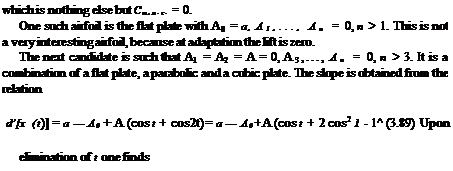Design the simplest airfoil (thin cambered plate) such that the center of pressure stays at the quarter-chord at all incidences (small a’s) and the design lift (Cl)des > 0 is obtained at the angle of adaptation aadapt. By simplest airfoil, we mean one that has the smallest number of non zero Fourier coefficients. This has a practical interest for a “flying wing” configuration, where the long fuselage providing a moment from the tail is not available to balance the pitching moment at different incidences.

|
|
|
Xc. p. A0 + A1 — “2r 1
C 4 (A0 + 4
|
|
|
|
|
Upon multiplying by the denominator (not zero, since C; = 0), one finds
|
|
|
|
|
 |
|
x x 2
d (x) = a — A0 + A 2 — 10 + 8 2
|
|
|
|
|
Integrating from 0 to x gives
|
|
 |
|
|
|
The condition that d (c) = 0 determines A0 = a — A. Substitution of this result in the expression of the lift coefficient results in Ci = 2n (a + – A). Finally, the equation of the camberline can be factorized as
d(x) = Ax (7 — 80 (l — 0 (3.92)
From the previous result, the ideal angle of attack is aadapt = A and the associated lift (Ci)adapt = nA = (Ci)des. This determines the unknown coefficient A:
|
|
|
|
|
|
|
A sketch of the thin cambered plate at incidence of adaptation is shown in Fig. 3.23.
|
|
|
Fig. 3.23 Thin cambered plate at design conditions
|
|
|
|
|
|
|
|
|
|
|
|
|
|
|
|
|


![]()


![]()











